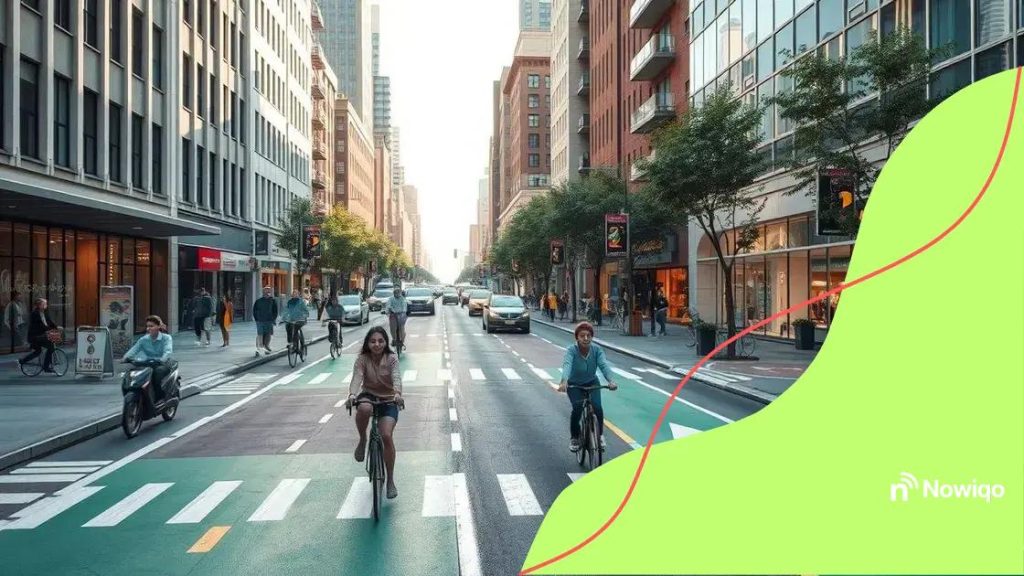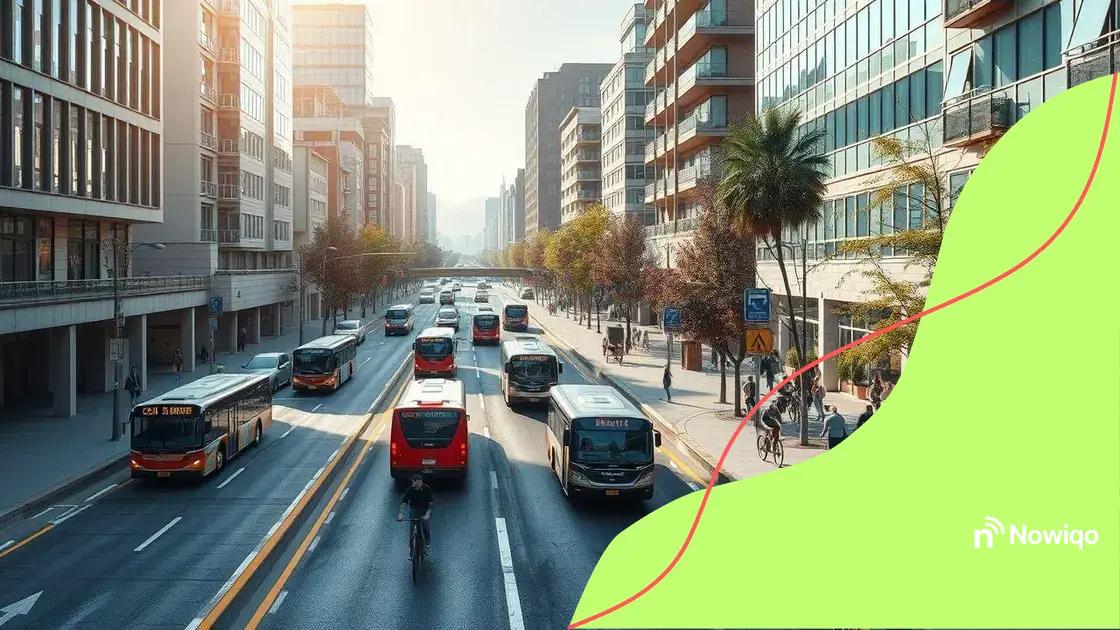Urban traffic reform: transforming our cities for the better

Anúncios
Urban traffic reform involves strategic improvements in transportation systems, using technology and community engagement to reduce congestion, enhance safety, and improve overall quality of life in cities.
Urban traffic reform is becoming a hot topic in cities worldwide. Have you ever felt stuck in traffic or wondered how congestion affects your daily life? Let’s dive into the ways we can make our cities more navigable and enjoyable for everyone.
Understanding urban traffic challenges
Understanding the urban traffic challenges we face today is crucial for any effective reform. Let’s explore some of the major issues that contribute to congestion and inefficiencies in our cities.
Anúncios
Major Factors Contributing to Traffic Issues
Several factors lead to the traffic congestion we see in urban areas. Recognizing these can help us find solutions.
- Population growth that outpaces infrastructure development
- Increased reliance on personal vehicles over public transport
- Poor urban planning that does not accommodate traffic flow
- Environmental variables, such as weather conditions affecting road use
When we consider these challenges, it’s clear why urban traffic reform is needed. Many cities struggle with outdated road designs that were not built for today’s traffic levels. For instance, roads that are too narrow can create bottlenecks, leading to delays.
Furthermore, as cities expand, the infrastructure often fails to keep up, resulting in more cars on the road than it can handle. This congestion not only affects travel times but also increases pollution and adds stress for drivers.
Anúncios
The Impact on Daily Life
Traffic congestion impacts our daily lives in several ways. A few concerns include:
- Longer commute times affecting work-life balance
- Decreased air quality leading to health issues
- Wasted time that could be spent more productively
- Increased likelihood of accidents
Recognizing these problems helps motivate the need for traffic reforms. Engaging communities in the reform process is essential. When people understand the issues, they are more likely to support solutions that improve transportation options.
As we delve deeper into solutions, remember that addressing urban traffic challenges is not just about building more roads. It involves innovative thinking, community input, and sustainable practices to reshape our urban environments.
Key strategies for effective traffic reform
Key strategies for effective traffic reform are vital for addressing the challenges faced in urban areas. Implementing these strategies can lead to smoother traffic flow and improved safety for all road users.
Promoting Public Transport
One of the most effective ways to reduce congestion is by encouraging the use of public transport. Cities that invest in reliable bus and train systems see a decrease in the number of cars on the road. Factors that make public transport appealing include:
- Affordability compared to owning a car
- Frequency and reliability of services
- Enhanced safety features
- Convenient routes that connect key areas
By making public transport a viable choice, cities can alleviate traffic hassles and cut down on emissions.
Implementing Smart Traffic Management
Another strategy involves the use of technology to improve traffic flow. Smart traffic management systems use sensors and real-time data to adjust traffic signals and inform drivers of conditions ahead. The benefits include:
- Reduced waiting times at intersections
- Better emergency response times
- Dynamic rerouting of traffic during congestion
- Improved safety due to reduced accident rates
These systems allow cities to be more proactive in managing their traffic challenges.
Moreover, prioritizing pedestrian pathways and bicycle lanes can encourage alternative modes of transport. When cities invest in safe and convenient routes for pedestrians and cyclists, they help reduce the reliance on vehicles.
Additionally, community engagement plays a crucial role in these reforms. Involving residents in the planning and decision-making process ensures that the strategies adopted align with their needs and preferences. Open forums and surveys can gather valuable input that shapes effective traffic measures.
Furthermore, zoning laws can be adjusted to promote mixed-use developments. This allows people to live closer to their workplaces, reducing the need for long commutes. As more individuals can walk or bike to work, overall traffic levels can decline.
Case studies from successful urban traffic reforms

Case studies from successful urban traffic reforms can provide valuable insights into effective strategies that cities have implemented. Examining these examples helps understand what works and why.
Example 1: Bogotá’s TransMilenio System
Bogotá, Colombia, introduced the TransMilenio bus rapid transit system to address severe traffic issues. This system has reduced travel times drastically and made public transport more efficient. By giving dedicated lanes to buses, congestion was lowered significantly. Riders enjoy:
- Faster commutes with fewer stops
- Increased safety through well-defined bus lanes
- Affordable fares that attract more users
This model has inspired many cities looking to improve their public transport systems.
Example 2: Paris and Bike Infrastructure
Paris has made strides to promote cycling through expanded bike lanes and bike-sharing programs. The city aims to reduce vehicular traffic while encouraging healthier travel methods. By creating safe and accessible bike lanes, they have seen a surge in cyclists. Benefits include:
- Lower traffic congestion during peak hours
- Improved air quality due to reduced vehicle emissions
- Increased physical activity among residents
This example showcases how focusing on alternative transport can effectively reshape urban mobility.
Furthermore, cities like Amsterdam are well-known for their cycling culture, which encourages people to choose bikes over cars. Amsterdam’s extensive network of bike lanes allows safe navigation throughout the city.
Moreover, lessons learned from failed implementations also teach valuable lessons. For example, cities must consider community feedback and urban design, ensuring that any reform aligns with the needs of residents. Highlighting these lessons helps new initiatives avoid past mistakes.
The role of technology in traffic management
The role of technology in traffic management is becoming increasingly important as cities strive to improve road safety and efficiency. With new innovations, transportation systems are transforming how we navigate urban landscapes.
Smart Traffic Signals
One of the key advancements in traffic management is the use of smart traffic signals. These systems adjust traffic light timings based on real-time data, which helps reduce congestion. Key features include:
- Adaptive signal control that responds to traffic flow
- Emergency vehicle preemption for faster response times
- Synchronization of lights to enhance overall traffic movement
These technologies help keep traffic flowing smoothly during peak hours.
Traffic Monitoring and Analytics
Another important aspect of using technology is monitoring traffic patterns. Cameras and sensors collect data on vehicle counts and speeds. This information is analyzed to determine:
- High congestion areas needing intervention
- Peak travel times to adjust traffic flow
- Accident-prone intersections that require safety measures
By understanding traffic behavior, cities can create targeted solutions for their unique challenges.
Moreover, mobile apps that provide real-time traffic updates empower drivers to make informed decisions. These apps inform users about delays, road closures, and alternative routes, allowing them to navigate more efficiently. This use of technology not only saves time but also reduces frustration during travel.
Furthermore, the integration of smart parking systems is revolutionizing urban mobility. These systems help drivers locate available parking spaces quickly, minimizing the time spent searching for a spot. This reduces unnecessary driving and contributes to lower emissions.
Finally, the use of data analytics to improve public transport systems is pivotal. Technology can optimize bus routes and schedules to match commuter demand, enhancing the appeal of public transportation.
Engaging communities in traffic reform efforts
Engaging communities in traffic reform efforts is essential for creating successful and lasting changes in urban areas. When residents take part in the planning and decision-making process, they feel a sense of ownership over the improvements made in their neighborhoods.
Importance of Community Involvement
Community involvement leads to better outcomes because local residents know their needs and concerns best. By including their voices, cities can tailor traffic reforms to serve the specific interests of the community. This can result in enhanced safety and accessibility for everyone.
Methods to Engage Residents
There are various ways to promote community engagement in traffic reform. Some effective methods include:
- Hosting town hall meetings that allow residents to express their opinions
- Creating online surveys to gather feedback on proposed changes
- Forming advisory committees with local stakeholders
- Organizing workshops to discuss traffic safety and improvements
These activities foster open dialogue and help identify the most pressing issues within the community.
Furthermore, using social media platforms can enhance outreach efforts. Sharing information and updates online makes it easier for residents to stay informed and involved. For example, cities can create dedicated pages highlighting traffic reform initiatives, gathering feedback and suggestions for improvements.
Another approach is involving schools and local organizations in reform efforts. Educational programs focused on traffic safety can empower young people to advocate for safer streets. Connecting with schools helps raise awareness and encourages community-wide discussions about transportation issues.
It’s also important to celebrate milestones and successes achieved through community engagement. Acknowledging contributions and progress reinforces the value of collaboration and motivates residents to remain involved.
FAQ – Frequently Asked Questions about Urban Traffic Reform
What is urban traffic reform?
Urban traffic reform refers to changes made to improve traffic flow, safety, and overall transportation systems in city environments.
Why is community engagement important in traffic reform?
Community engagement ensures that the needs and concerns of residents are addressed, leading to more effective and accepted traffic solutions.
How does technology help in traffic management?
Technology improves traffic management by using data and smart systems to optimize traffic signals, monitor conditions, and enhance public transport.
What are the benefits of successful traffic reform?
Successful traffic reform leads to reduced congestion, safer streets, improved public transport, and higher quality of life for residents.